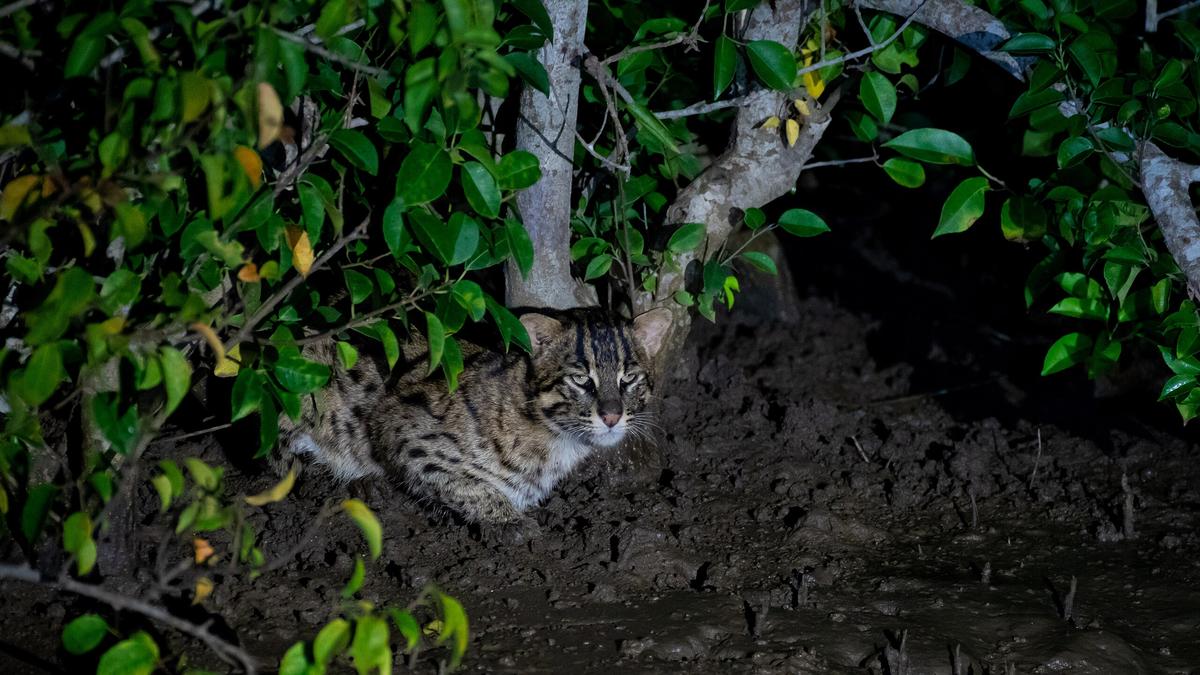A fishing cat among mangroves in the Godavari river at night, 2018.
| Photo Credit: Srichakra Pranav (CC BY-SA)
In the wild, India has 15 species belonging to the cat family. Much attention has been given to our large cats, the lions and tigers. Not much is known of the smaller wild cats – the caracal, the rusty spotted cat, the fishing cat, etc. These smaller, more secretive cats deserve due recognition, as they navigate a world increasingly full of threats far larger than themselves.
Wetlands in India are home to the fishing cat, which grows to twice the size of the domestic cat, weighs seven to 12 kg, and has a greyish brown fur lined with black spots. In its territory, this cat is often the apex predator, meaning no other creature preys on it. Wetlands are vibrant ecosystems characterised by waterlogged soil like that found in river floodplains, mangroves, and swamps.
Some unusual adaptations enable the fishing cat to get by in wet surroundings. Partially webbed paws, a dense water-resistant coat and the ability to swim while fully submerged in water indicate aquatic leanings. Protruding claws, which cannot be fully retracted, help the cat with gripping slippery mud and fish. The cats’ diet is primarily fish, although rodents, chickens, and other small animals are always welcome.
The fishing cat spends 50% of its hunting time standing, sitting or crouching near the edge of water. Barely 5% of hunting time is spent submerged in water. In shallow water, the cat keeps moving slowly, pausing to flush a fish out with its paws before grabbing it with the mouth.
Populations of the fishing cat are found in scattered pockets: the terai region of the Himalayas, some marshes of Western India, the Sundarbans, along the East coast, and in Sri Lanka.
Wildlife surveys for keeping track of the patchy populations of this elusive nocturnal cat utilise camera traps set near the water’s edge. An elaborate count has been conducted by Tiasa Adhya of the Fishing Cat Project and a network of collaborators (see fishingcat.org) in the Chilka lake, where there is an abundance of fish and limited conflict with humans. Extrapolating their results gives us an estimate of about 750 fishing cats in the 1,100 sq. km expanse of the lagoon (see: Endangered Species Research, 54, 1, 2024).
This healthy number contrasts with the cats’ rapidly dwindling numbers in the Sundarbans. Fishing cats were thought to have died out in Rajasthan until sightings in the Keoladeo National Park earlier this year.
The decline is largely on account of habitat loss. It has been estimated that 30-40% of India’s wetlands have been lost or severely degraded in the last four decades. Protecting wetland ecosystems is therefore crucial for the fishing cat. Human encroachment has also severely affected them. Many people see them as predators of fish ponds and chicken coops, and an alarming number of revenge kills by humans have been documented. Community-based conservation programmes appear to hold the key to reducing this animosity.
This year, the Wildlife Institute of India in Dehradun has initiated a project to track fishing cats in the estuaries of the Godavari river within the Coringa Wildlife Sanctuary near Kakinada in Andhra Pradesh. Using GPS collars with GIS integration, precise location data of collared cats will be collected. Continuous data from the collars will provide insights on preferred habitats, movement, and where they encounter human settlements. All these will be useful for designing strategies to boost fishing cat populations.
This article was co-authored with Sushil Chandani.
Published – August 09, 2025 09:00 am IST
